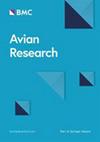Transcontinental evolutionary dynamics and phylogeography of Alectoris (Aves: Galliformes): Identifying refugia, dispersal corridors, and cryptic diversity in the Palearctic region
IF 1.7
2区 生物学
Q1 ORNITHOLOGY
引用次数: 0
Abstract
The Alectoris (Galliformes: Phasianidae) has a wide distribution range in the Palearctic region, with seven species and 27–31 subspecies that were distinguishable by minor morphological differences. The members of the genus exhibit distinct genetic structuring compatible with geography due to their inability to make long flights and ground-dwelling behaviors. In this respect, the evolutionary history of the genus and its populations is a useful tool for identifying potential cryptic refugia, dispersal corridors, and strong barriers for bird species in the Palearctic region. On the other hand, wild populations of the genus are among the bird species most affected by human activities. For this purpose, sequences from the mitochondrial D-loop and Cyt-b regions of individuals from the genus Alectoris were studied to identify the evolutionary history of the genus, determine potential cryptic species, and reveal possible hidden diversification areas in the Palearctic region. The results indicated that: the Mediterranean basin is the ancestral area of the Alectoris, there are two main diversification centers within its distribution range (Mediterranean Basin and China) of the genus, and certain micro-refugia and permanent dispersal corridors have been observed in Eastern Palaearctic region. Additionally, the results showed that the Pleistocene climatic changes acted as a species pump, playing a significant role in the diversification of lineages within the genus. Anatolia served as the ancestral area for the A. chukar and acted as a bridgehead during the species' dispersal in the inner side of the Eastern Palaearctic. High mountain ranges, monsoonal climate types, and deserts in the Eastern Palearctic played a significant role in the dispersal and diversification of the ancestral A. chukar population. Importantly, human activities appear to be the greatest evolutionary force shaping the future evolution of the genus.
鸦形目的跨大陆进化动力学和系统地理学:确定古北地区的避难所、扩散走廊和隐蔽多样性
Alectoris(加利亚目:Phasianidae)在古北地区分布广泛,有7种和27-31个亚种,形态学差异较小。该属的成员由于无法长途飞行和地面生活行为而表现出与地理相容的独特遗传结构。在这方面,该属及其种群的进化历史是确定古北地区鸟类潜在的隐蔽避难所、传播走廊和强大屏障的有用工具。另一方面,该属的野生种群是受人类活动影响最大的鸟类之一。为此,研究了Alectoris属个体线粒体D-loop和Cyt-b区域的序列,以确定该属的进化史,确定潜在的隐种,并揭示古北区可能隐藏的多样化区域。结果表明:地中海盆地是该属植物的发源区,其分布范围内主要有地中海盆地和中国两个多样化中心,古北东部地区有一定的微避难所和永久扩散走廊。此外,更新世气候变化作为物种泵,在属内的谱系多样化中起着重要作用。安纳托利亚是a . chukar的祖先区,并在该物种向古北东部内部扩散的过程中发挥了桥头堡的作用。古北纬东部地区的高山、季风气候类型和沙漠对古楚卡古树种群的分散和多样化起着重要作用。重要的是,人类活动似乎是塑造该属未来进化的最大进化力量。
本文章由计算机程序翻译,如有差异,请以英文原文为准。
求助全文
约1分钟内获得全文
求助全文
来源期刊

Avian Research
ORNITHOLOGY-
CiteScore
2.90
自引率
16.70%
发文量
456
审稿时长
46 days
期刊介绍:
Avian Research is an open access, peer-reviewed journal publishing high quality research and review articles on all aspects of ornithology from all over the world. It aims to report the latest and most significant progress in ornithology and to encourage exchange of ideas among international ornithologists. As an open access journal, Avian Research provides a unique opportunity to publish high quality contents that will be internationally accessible to any reader at no cost.
 求助内容:
求助内容: 应助结果提醒方式:
应助结果提醒方式:


